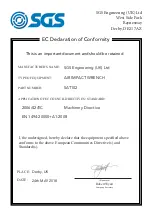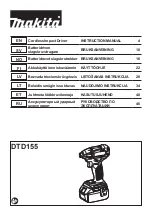
PAGE 7
PAGE 6
SAFETY INSTRUCTIONS
RISK OF INJURY
WHAT COULD HAPPEN
HOW TO PREVENT IT
Fasteners could ricochet or be propelled
causing serious injury or property damage.
Never point or discharge tool at self or
others. Do not pull trigger unless tool con-
tact safety device is against work surface.
Never attempt to drive fasteners into hard
surfaces such as steel, concrete, or tile.
Avoid driving a fastener on top of another
fastener. Position tool carefully so that
fasteners will be delivered to the proper
location.
Improperly maintained tools and accesso-
ries can cause serious injury.
Maintain the tool with care.
Keep a cutting tool sharp and clean. A
properly maintained tool, with sharp cut-
ting edges, reduces the risk of binding
and is easier to control.
There is a risk of bursting if the tool is
damaged.
Check for misalignment or binding of mov-
ing parts, breakage of parts and any other
condition that affects the tool’s operation.
If damaged, have the tool serviced and
repaired before use.
Use only accessories identified by SGS En-
gineering as suitable for use with specific
tools.
Use of an accessory not intended for a
specific tool increases the risk of injury to
persons.
RISK OF ENTANGLEMENT
WHAT COULD HAPPEN
HOW TO PREVENT IT
Tools which contain moving elements, or
drive other moving parts, such as grinding
wheels, sockets, sanding discs, etc. can
become entangled in hair, clothing, jewel-
lery and other loose objects resulting in
severe injury.
Never wear loose fitting clothes or apparel
that contains loose straps or ties which
could become entangled in moving parts
of the tools. Remove any jewellery, watch-
es, identifications, bracelets or necklaces
which might become caught by the tool.
Keep hands away from moving parts. Tie
up or cover long hair. Always wear proper
fitting clothing and other safety equip-
ment when using the tool.
SETTING UP THE AIR LINE
1. Make sure that the air compressor being used for the air tool opera-
tion supplies the correct output (CFM).
2. Have the tool in the “off” position when connecting the tool to the air
supply.
3. Use normal 90 PSI (or ranging from 6.0 to 8.0kg) air pressure while
running the tool. High pressure and unclean air will shorten the tool’s
life due to faster wear and may also create a hazardous situation.
4. Drain water from air compressor tank daily as well as any condensa-
tion in the air lines. Water in the air line may enter the tool and dam-
age the tool mechanisms at operation.
5. Clean the air inlet filter cartridge weekly. The recommended hook-up
procedure can be viewed in the diagram below.
6. Line pressure should be increased accordingly to make up for extra
long air hoses (usually over 8 metres). The minimum hose diameter
should be 1/4” I.D. and the fittings should have the same inside
dimensions. But usually a 3/8” I.D. air hose is recommended for air
supply to get the best function of air tool operation.
7. Use proper hoses and fittings. We do not suggest connecting quick
change couplings directly to the tool since they may cause failure due
to vibration. Instead, add a leader hose and connect coupling be-
tween air supply and hose whip.
8. Check hoses for wear before individual use. Make certain that all con-
nections are securely fastened.
1
WWW.SGS-ENGINEERING.COM

























